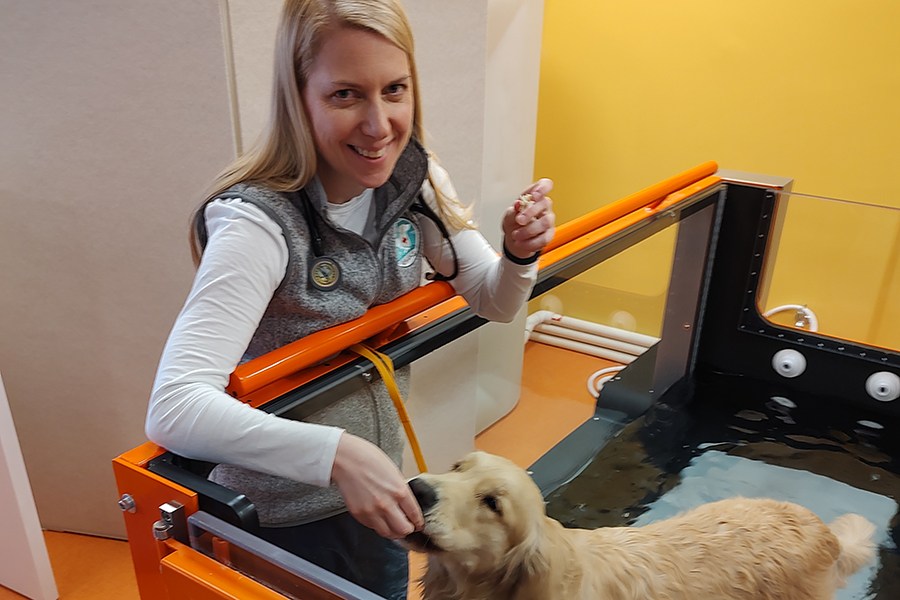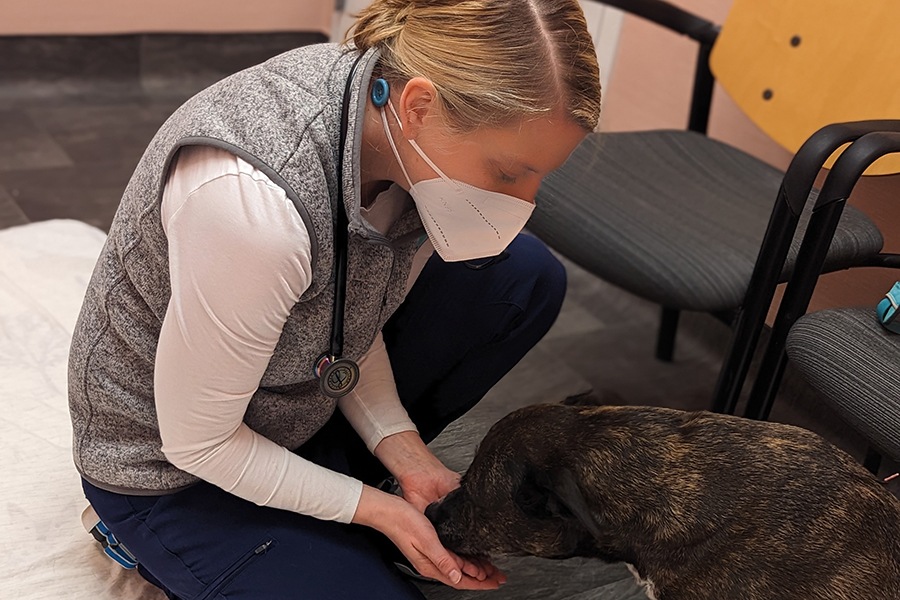Having a Pet in Boston Can Be Tricky. A Local Vet Explains How to Keep Yours Happy and Healthy

Having a pet is one of the simplest joys in life, and one of the biggest responsibilities. They keep life interesting with their personalities and quirks, and keep us company day after day. But they have pain and medical complications just like us. That’s why it’s important to find a local vet who will take the absolute best care of them, especially as they experience pain.
All pets face health risks like arthritis, obesity, injury, and illness. But Dr. Jaclyn Coble of the innovative new veterinary practice, Sea Legs Integrative Veterinary Health in West Roxbury, is highly trained in treating those issues with her holistic approach to healing and pain management.
We asked Dr. Coble about all the innovative and tried-and-true services Sea Legs offers to help your pet find comfort when they’re experiencing pain. Here’s everything you need to know.
Pain Assessments
If you know or suspect your pet is experiencing pain, Dr. Coble recommends a pain assessment to identify the problem. “We’ll observe the pet walking, trotting, or running, and then we do palpation— feeling the joints and muscles,” she says. “We also take specific measurements of muscle mass and range of motion.” In some cases, the team will do X-rays.
A pain assessment is useful in cases where animals are good at hiding their pain—but Dr. Coble also says to watch for signs at home so you know when it’s time to take your pet into Sea Legs.
For dogs, Dr. Coble notes that certain breeds are more susceptible to painful conditions. “Smaller dogs, including French bulldogs and dachshunds, are genetically predisposed to having intervertebral disc disease,” Dr. Coble says. Because of this, they can be prone to disc herniations, back arthritis, and muscle spasms.
In cats, especially older feline patients, arthritis in the elbows and back is common, but it can be tricky to detect. “It can be that they just aren’t taking as many steps around the house—but who measures that?” she says. Instead, monitor your cat’s behavior and personality changes. “If [the cat] seems like it’s not as active, or more irritable, or even eating a little bit less, that can be a sign that they should be assessed for pain.”
Dr. Coble’s rule of thumb is that if you’re worried a certain everyday activity, like walking, has become too uncomfortable for your dog or cat, you should bring them to Sea Legs for a pain assessment and treatment plan.

Rehabilitation by Hydrotherapy
Every pet at Sea Legs gets a tailored treatment plan. For some, that may involve physical rehabilitation for your pet. Physical rehabilitation is the veterinary term for physical therapy. Commonly, Dr. Coble tells us, animals who are overweight, have arthritis, or both, will benefit from rehabilitation.
For dogs who are overweight and may already have some arthritis, Dr. Coble says, suddenly going for a long walk in an effort to exercise them can be overwhelming for their bodies. “It’s hard on them, and they can get really sore and uncomfortable,” she says. Rehabilitation at Sea Legs can help them ease into exercise.
The team at Sea Legs can also conduct weight loss therapy with a combination of nutrition consults—making sure the dog is on the proper diet for their specific needs—and monitored hydrotherapy, which is exercise on Sea Legs’ UV-filtered saltwater treadmill. “It’s easier for a dog that hasn’t exercised much to start there, because the buoyancy takes the stress off of their joints,” she says.
Hydrotherapy is a lower-impact exercise for dogs experiencing pain of all kinds, whether they are obese or not. This includes dogs who have been injured or undergone surgery, like a torn cranial cruciate ligament repair.
Across the board, physical rehabilitation can help pets with a range of issues—from arthritis to acute and chronic injuries–just like how people benefit from physical therapy.
Pain Management by Acupuncture
Sea Legs also offers the Eastern practice of acupuncture, which can make a difference in many Boston pets’ lives. Dr. Coble learned to integrate acupuncture into her veterinary practice at Chi University in Florida, which teaches traditional Chinese veterinary medicine.
Dr. Coble says acupuncture in animals is similar to how it’s used in humans. “Most of the points that we use in pets are derived from points we use in people,” she says. “They’re typically located around places that have a lot of nerve concentrations, and small arteries and veins.” When you stimulate those points, she explains, it can increase the body’s circulating endorphins. “Those are the body’s natural painkillers,” she says.
Acupuncture can also lead to migration of anti-inflammatory factors and even be used to treat behavioral issues and chronic internal medicine conditions. Dr. Coble explains that acupuncture can even be combined with conventional treatments for cancer to keep our pets as comfortable as possible.

Pharmaceutical Care
At Sea Legs, your pet’s treatment plan will likely be a multimodal approach with both alternative modes of therapy and medication. “We approach it from all angles,” says Dr. Coble. This is what makes her practice so innovative—they offer pain management like hydrotherapy and acupuncture, but they also understand the importance of medication when it’s necessary.
An initial example for those with pets who are scared of the vet: “Some kitties just do not like being at the vet, and as soon as you get them in a carrier they’re hitting and trying to strike,” she says. “So sometimes we’ll give them medication to make them more calm when they’re here.”

Palliative Care
Although it’s difficult to come to terms with, our pets can’t live forever. Dr. Coble knows this better than anyone, having treated pets with life-limiting illnesses and knowing the signs that it may be time to withdraw curative treatment. At that point, she says, they will shift the focus. “Basically, we will focus our treatment on keeping the pets comfortable and maintaining their quality of life with their people,” she says.
“We can do palliative care to make sure the pet maintains a good quality of life with the days that they have left.” At that point where your pet seems like they’re uninterested in playing ball or going for a walk, not eating, or snuggling with their owners in the home, Dr. Coble and the Sea Legs team helps owners make the difficult decision to opt for euthanasia. “At what point are we keeping them around just for us and not for them? This is what we help guide owners through.” she says.
“We have a special comfort room that has a pretty mural in it, and a couch on the floor so that people can stay and snuggle with their pets and be present for their end of life care,” she says, and explains that the cremation company has various grief services to support you through your loss.
Sea Legs and Dr. Coble’s bottom line: “Nobody wants their pet to be in pain,” she says.
Sea Legs Integrative Veterinary Health specializes in individualized care for animals suffering from pain, decreased mobility, illness or injury. To learn more and make your appointment, visit sealegsvet.com.
This is a paid partnership between Sea Legs Integrative Veterinary Health and Boston Magazine